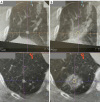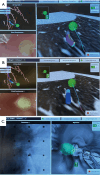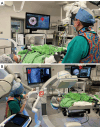Review on endobronchial therapies-current status and future
- PMID: 39118957
- PMCID: PMC11304415
- DOI: 10.21037/atm-23-1430
Review on endobronchial therapies-current status and future
Abstract
There is a growing demand for lung parenchymal-sparing localized therapies due to the rising incidence of multifocal lung cancers and the growing number of patients who cannot undergo surgery. Lung cancer screening has led to the discovery of more pre-malignant or early-stage lung cancers, and the focus has shifted from treatment to prevention. Transbronchial therapy is an important tool in the local treatment of lung cancers, with microwave ablation showing promise based on early and mid-term results. To improve the precision and efficiency of transbronchial ablation, adjuncts such as mobile C-arm platforms, software to correct for computed tomography (CT)-to-body divergence, metal-containing nanoparticles, and robotic bronchoscopy are useful. Other forms of energy such as steam vapor therapy, pulsed electric field, and photodynamic therapy are being intensively investigated. In addition, the future of transbronchial therapies may involve the intratumoral injection of novel agents such as immunomodulating agents, gene therapies, and chimeric antigen receptor T cells. Extensive pre-clinical and some clinical research has shown the synergistic abscopal effect of combination of these agents with ablation. This article aims to provide the latest updates on these technologies and explore their most likely future applications.
Keywords: Transbronchial ablation; microwave ablation; photo dynamic therapy; pulsed electric field; robotic bronchoscopy.
2024 Annals of Translational Medicine. All rights reserved.
Conflict of interest statement
Conflicts of Interest: All authors have completed the ICMJE uniform disclosure form (available at https://atm.amegroups.com/article/view/10.21037/atm-23-1430/coif). The series “Lung Cancer Management—The Next Decade” was commissioned by the editorial office without any funding or sponsorship. C.S.H.N. served as the unpaid Guest Editor of the series and serves as the Editor-in-Chief of Annals of Translational Medicine from January 2022 to December 2023. He is also a consultant for Johnson and Johnson, Medtronic USA and Siemens Healthineer. R.W.H.L. is a consultant for Medtronic USA and Siemens Healthineer. The authors have no other conflicts of interest to declare.
Figures








Similar articles
-
Transbronchial Techniques for Lung Cancer Treatment: Where Are We Now?Cancers (Basel). 2023 Feb 8;15(4):1068. doi: 10.3390/cancers15041068. Cancers (Basel). 2023. PMID: 36831411 Free PMC article. Review.
-
Electromagnetic navigation bronchoscopy transbronchial lung nodule ablation with IllumisiteTM platform corrects CT-to-body divergence with tomosynthesis and improves ablation workflow: a case report.AME Case Rep. 2023 Feb 20;7:13. doi: 10.21037/acr-22-49. eCollection 2023. AME Case Rep. 2023. PMID: 37122960 Free PMC article.
-
Advanced Imaging for Robotic Bronchoscopy: A Review.Diagnostics (Basel). 2023 Mar 5;13(5):990. doi: 10.3390/diagnostics13050990. Diagnostics (Basel). 2023. PMID: 36900134 Free PMC article. Review.
-
Recent Advances in Bronchoscopic Treatment of Peripheral Lung Cancers.Chest. 2017 Mar;151(3):674-685. doi: 10.1016/j.chest.2016.05.025. Epub 2016 Jun 10. Chest. 2017. PMID: 27292045 Review.
-
Transbronchial microwave ablation of lung nodules with electromagnetic navigation bronchoscopy guidance-a novel technique and initial experience with 30 cases.Transl Lung Cancer Res. 2021 Apr;10(4):1608-1622. doi: 10.21037/tlcr-20-1231. Transl Lung Cancer Res. 2021. PMID: 34012778 Free PMC article.
Cited by
-
Robotic-assisted bronchoscopy-advancing lung cancer management.Front Surg. 2025 Jun 3;12:1566902. doi: 10.3389/fsurg.2025.1566902. eCollection 2025. Front Surg. 2025. PMID: 40529888 Free PMC article. Review.
-
Chinese expert consensus on shape-sensing robotic-assisted bronchoscopy (ssRAB) in the management of peripheral pulmonary lesions.Transl Lung Cancer Res. 2025 May 30;14(5):1500-1515. doi: 10.21037/tlcr-2025-400. Epub 2025 May 28. Transl Lung Cancer Res. 2025. PMID: 40535069 Free PMC article. Review.
-
Two-phase radial endobronchial ultrasound bronchoscopy registration.J Med Imaging (Bellingham). 2025 Mar;12(2):025001. doi: 10.1117/1.JMI.12.2.025001. Epub 2025 Mar 7. J Med Imaging (Bellingham). 2025. PMID: 40061857
References
-
- Chan JWY, Lau R, Chang A, et al. 96P Transbronchial microwave ablation: Important role in the battle of lung preservation for multifocal lung primaries or metastases. Ann Oncol 2022;33:S76-7.
Publication types
LinkOut - more resources
Full Text Sources
